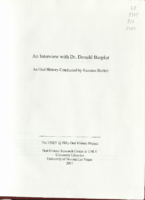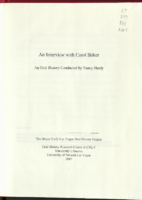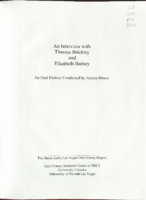Search the Special Collections and Archives Portal
Search Results

Transcript of interview with Russell H. Allen by Izola Olsen, March 10, 1981
Date
1981-03-10
Archival Collection
Description
Isola Olsen interviews school teacher-principal Russell H. Allen (b. 1914) at his place of residence in North Las Vegas, Nevada. Born in Mesa, Arizona, Allen relocated to Nevada in 1953. During the interview Allen discusses home life, living and working in Alamo, Nevada, teaching, and changes of education.
Text

Transcript of interview Skip Allen by Henry Pierzchala, February 27, 1980
Date
1980-02-27
Archival Collection
Description
Henry Pierzchala interviews Skip Allen (born 1935 in Somerset, Kentucky) about his early experiences in Las Vegas. Allen discusses some of his experience from a position in human resources for the military, as well as working for his father in a business in the area of what is now the Las Vegas Strip. Allen also describes recreational activities, his views on morality while living in Las Vegas, and some of his later experiences in hospitality, specifically in the food and beverage and hotel industries.
Text

Transcript of interview with Robert Allen III by Leonardo Gray, March 21, 1978
Date
1978-03-21
Archival Collection
Description
Leonardo Gray interviews his neighbor, local electrician Robert Allen III (b. 1947) at his home in Las Vegas, Nevada. Born in Frankfort, Kentucky, Allen relocated to Nevada in 1953. During this interview Allen discusses the history of Las Vegas from his perspective, high school in Nevada, casinos, local television stations, sports and recreation, and the Strip.
Text

Transcript of interview with Dorothy Engel Andre by Elizabeth Nelson Patrick, October 17, 1980
Date
1980-10-17
Archival Collection
Description
Dorothy Engel Andre (b. 1898), was born in New York City. She relocated to Nevada in 1922. The interview takes place within the Andres’ home and Dorothy interviewed by Elizabeth Patrick Nelson. During this interview Mrs. Andre, a homemaker, discusses her life experiences with emphasis on her life in Nevada. Her husband is also present during the interview.
Text

Transcript of interview with Bill Armstrong by Anthony Robone, February 28, 1979
Date
1979-02-28
Archival Collection
Description
Anthony Robone interviews Bill Armstrong (born in Kentucky in 1921) in Armstrong’s apartment complex about his experiences in Las Vegas. Robone asks a variety of questions relating to Armstrong’s bootlegging in Kentucky before he arrived in Las Vegas, his involvement with the Las Vegas Dealers, the weather as it relates to other parts of the country, the impacts of the work of Howard Hughes on the town, the construction of Hoover Dam, the above ground atomic testing, the growth of Las Vegas and tourism, changes in gambling habits for the next generation, and the social and recreational activities residents took part in.
Text

Transcript of interview with Dr. Donald Baepler by Suzanne Becker, April 23, 2007
Date
2007-04-23
Archival Collection
Description
Dr. Donald Baepler was born in Edmonton, Alberta, Canada in July of 1932. The family moved to Springfield, Illinois in 1936, where his father was president of Concordia Seminary. Donald decided at the age of seven that he wanted to pursue a Ph.D. in ornithology, not an unusual goal in his family. By the time he graduated high school, he knew that he wanted to attend Carlton College in Minnesota to study under Olin Sewall Pettingill. He followed world-famous ornithologist and artist George Sutton to Michigan and then to Oklahoma to complete his doctorate. In 1960, having completed his doctorate, Donald met with a recruiter from Las Vegas. It seemed like an intriguing place, so he took the interview and was offered a job on the spot. Instead, he took a job as professor of biology at Central Washington University, and within four years was vice president for administration and business. He had also been appointed to an accrediting team by the Northwest Association to accredit colleges in the western states, including Nevada Southern University in Las Vegas, and saw the growing town and university for the first time in 1965. Two years later, he was invited to take the job of Academic Vice President at SNU, which he accepted, and he and his family made the move to Las Vegas in 1968. Upon arriving in Las Vegas, Donald discovered that he had been named acting president because of Donald Moyer's abrupt resignation. He simply decided to do both jobs. He was successful in changing the name of the school to University of Nevada Las Vegas so that it would not be confused with a teacher's college. This was wholeheartedly accepted by the regents. Once Roman Zom was appointed president in 1969, Donald went back to the vice president position. In 1973, Dr. Baepler was appointed president of UNLV. He held that position for live years and then turned in his resignation. His intent was to teach, focus on a Museum of Natural History, and start a research center. Instead, he was offered the chancellorship of the university system, and he decided to accept the job By 1981, Donald was ready to return to teaching and research, so he resigned as chancellor and came back full-time as museum director and professor of biology. He built up a high-hazard chemistry lab and got the grant monies to sustain it. Dr. Baepler was also influential in adding the Harry Reid Center to the museum. Today Dr. Baepler is still involved with the bird program and gives advice to graduate students, but he no longer teaches. He stays occupied with a private consulting business.
Text

Transcript of interview with Carol Baker by Nancy Hardy, May 29, 2003
Date
2003-05-29
Archival Collection
Description
In 1943, Carol Baker was born in a small village in England near Walton-on- Thames. Her successful entry into entertainment began when she joined the legendary dance troupe known as the Bluebell Girls. She danced at the Lido in Paris before arriving in Las Vegas in 1963. Madam Bluebell rehearsed the group in Italy for their initial Las Vegas show at the Dunes Hotel. After leaving Las Vegas to return home for a few months, Carol received an offer to be a part of the Folies Bergere at the Tropicana. She gave excellent accounts of what a typical day was like for an entertainer on the Strip including backstage life, parties, and relationships among dancers. Alter performing in shows in Las Vegas and around the world - Amsterdam, the Bahamas, Puerto Rico, and Paris - Carol and her husband settled down in Las Vegas and raised their children. She ended her dance career in a show at the Holiday Inn. Then she went on to share her knowledge of dancing by teaching at the Wonderland School of Dance. Today she owns a Wonderland School of Dance in Southern California, operating it from Las Vegas.
Text

Transcript of interview with Theresa Brickley and Liz Burkey by Andres Moses, January 27, 2006
Date
2006-01-27
Archival Collection
Description
Theresa Brickley and Elizabeth Burkey come from very different corners of the world, but were united by dance in Las Vegas. Theresa was bom and raised in Tokyo, and immigrated to the United States with her American husband. Elizabeth, better known as Liz, was bom in Detroit, Michigan into a family of performance artists. Theresa's first dance job was disrupted by World War II, while Liz's break came when becoming a Rockette at Radio City Music Hall. Migrating to Las Vegas from Seattle and California respectively, the two met as performers in the Sun City Dance Company, and became the best of friends. They have performed all over the city, including Sahara, Rio, and Mirage, to name a few.
Text

Transcript of interview with Myrtle Banks by George Williams, March 15, 1981
Date
1981-03-15
Archival Collection
Description
George Williams interviews Myrtle Banks (b. 1923) in her home while Lucille Bell is also present and occasionally provides additional commentary. They discuss African American history in Nevada, specifically in the context of job opportunities, relationships with whites, and the social and political changes that took place over time. Banks also discusses the riots of the 1960s, changes in crime rates and their effect on perception of safety, constructional increases and population growth, shopping and price changes on various products, and how gambling and entertainment defined Las Vegas.
Text

Transcript of interview with Thomas Barbarite by Dennis Chamberland, March 3, 1981
Date
1981-03-03
Archival Collection
Description
Dennis Chamberland interviews Thomas Barbarite (b. 1932) in his home about his time in Las Vegas and his experiences in the casino industry. Barbarite discusses his time at the Four Queens and the Dunes as a dealer as well as his work as a pit boss at the Flamingo, the Aladdin, and Caesars Palace. Chamberland also asks Barbarite about the changes over time on the Strip, including the disappearance of lounge shows and expansion of larger shows on the Strip. Barbarite also discusses the involvement of the mob in Las Vegas, particularly the influence of Bugsy Siegel in the operation of various properties.
Text
Pagination
Refine my results
Content Type
Creator or Contributor
Subject
Archival Collection
Digital Project
Resource Type
Year
Material Type
Place
Language
Records Classification
